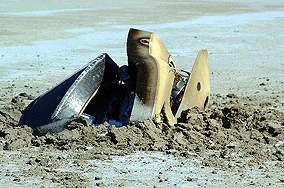One Small Slip for Man, One Giant Flop for Mankind
Remember the Genesis space capsule? The probe that, on completing its mission and collecting scads of valuable data and particles of solar wind, was, on its return, meant to drift gently in the air like a dandelion spore until a helicopter could snatch it out of the sky, but instead plummeted into the Utah desert floor as though ejected from the explosive rump of a bombardier beetle? NASA engineers are chuckling now at the fact that the explanation for the crash appears to be just one of those quirky little bloopers than can scuttle any $264 million space mission.

It appears that the gravity switches that were meant to trigger the parachutes' release on the Genesis’ return were installed, in a word, upside-down. One can infer that, had the capsule been swooshing rapidly upward rather than plunging to its doom, the chutes could probably have deployed just fine. Unfortunately, on Earth gravity tends to pull objects in a downward direction, with the tragic result that the chutes did not deploy and the probe, along with most of its solar wind particles, was demolished.

Oops.
How did the switches get installed upside-down? Simple human error, one would think. I sometimes put the batteries in backwards in my son’s subsequently inert Choo-choo, after all, so why should NASA be any different when constructing a $264 million space probe?
But NASA rests the blame for the failure squarely on the shoulders of Lockheed Martin, the outfit that has also been fingered for the failure of two previous Mars missions and that ranks as the number one defense contractor for the United States, with over $30 billion in defense revenue in 2003. Lockheed is also one of the top contractors responsible for developing Bush’s revitalized Reagan-era "Missile Defense Shield".
NASA claims the switches were installed precisely as indicated on Lockheed Martin’s design drawings. Lockheed Martin’s design, in other words, indicated one should install the gravity switches upside-down. The difference is illustrated schematically below:
( gUP <-> gDOWN )
where g = gravity
I don’t know about you, but I see no reason that Lockheed’s failure to grasp a pesky little detail such as which direction gravity works in should undermine one’s confidence in a missile defense system that’s supposed to do the equivalent of hitting a bullet with a bullet – only much moreso, as the first bullet’s trajectory would be unknown and extremely variable. But it does make one scratch one’s head in a thoughtful manner and muse whether the billions in taxpayer money they're getting for the system are being used quite as wisely as they could be. Perhaps the money would be better spent training and equipping a crack task force of deadly accurate, airborne anti-ballistic bombardier beetles.

0 Comments:
Post a Comment
<< Home